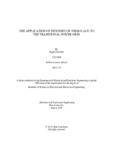| dc.contributor.advisor | Sabuj, Saifur Rahman | |
| dc.contributor.author | Morshed, Ragib | |
| dc.contributor.author | Ahmed, Fabliha Lamisa | |
| dc.date.accessioned | 2020-01-22T04:16:43Z | |
| dc.date.available | 2020-01-22T04:16:43Z | |
| dc.date.copyright | 2019 | |
| dc.date.issued | 2019-08 | |
| dc.identifier.other | ID 15221004 | |
| dc.identifier.other | ID 19121155 | |
| dc.identifier.uri | http://hdl.handle.net/10361/13659 | |
| dc.description | This thesis is submitted in partial fulfillment of the requirements for the degree of Bachelor of Science in Electrical and Electronic Engineering, 2019. | en_US |
| dc.description | Cataloged from PDF version of thesis. | |
| dc.description | Includes bibliographical references (pages 49-50). | |
| dc.description.abstract | The use of Internet of Things (IoT) in the traditional power grid has the potential to pave the way for the deployment of modernized Smart Grid in Bangladesh. This integration of IoT will not only cater for the exponential rise in demand for energy, but also to improve the reliability of the data sent to the control station. The system is used to prioritize effectiveness and security as it gives consumers a way to track their power usage and manage electricity better. This intelligent infrastructure is used to analyze the accuracy of data transmission after it is passed through the Additive White Gaussian Noise (AWGN) channel. The data is collected and converted into binary digits via a transmitter and then sent to the receiver. The main purpose of this paper is to methodically examine the coherence and integrity of the data by comparing the information at the transmitter and receiver sides and evaluating the signal-to-noise ratio (SNR) to estimate the percentage error in the system. We observed approximately 20% more packet loss for the same SNR values in the 1 second delay case than the 0 second delay case. Hence, the feasibility of the IoT was determined. | en_US |
| dc.description.statementofresponsibility | Ragib Morshed | |
| dc.description.statementofresponsibility | Fabliha Lamisa Ahmed | |
| dc.format.extent | 50 pages | |
| dc.language.iso | en | en_US |
| dc.publisher | Brac University | en_US |
| dc.rights | Brac University theses are protected by copyright. They may be viewed from this source for any purpose, but reproduction or distribution in any format is prohibited without written permission. | |
| dc.subject | Smart grid | en_US |
| dc.subject | SNR | en_US |
| dc.subject | AWGN | en_US |
| dc.subject | IoT | en_US |
| dc.subject.lcsh | Internet of things. | |
| dc.subject.lcsh | Internet of things--Power supply. | |
| dc.title | The application of Internet Of Things (IoT) to the traditional power grid | en_US |
| dc.type | Thesis | en_US |
| dc.contributor.department | Department of Electrical and Electronic Engineering, Brac University | |
| dc.description.degree | B. Electrical and Electronic Engineering | |

